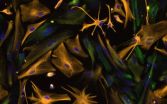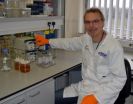(Press-News.org) Researchers at the University of California, San Diego School of Medicine have discovered that a well-known protein has a new function: It acts in a biological circuit to determine whether an immature neural cell remains in a stem-like state or proceeds to become a functional neuron.
The findings, published in the February 13 online issue of Cell Reports, more fully illuminate a fundamental but still poorly understood cellular act – and may have significant implications for future development of new therapies for specific neurological disorders, including autism and schizophrenia.
Postdoctoral fellow Chih-Hong Lou, working with principal investigator Miles F. Wilkinson, PhD, professor in the Department of Reproductive Medicine and a member of the UC San Diego Institute for Genomic Medicine, and other colleagues, discovered that this critical biological decision is controlled by UPF1, a protein essential for the nonsense-mediated RNA decay (NMD) pathway.
NMD was previously established to have two broad roles. First, it is a quality control mechanism used by cells to eliminate faulty messenger RNA (mRNA) – molecules that help transcribe genetic information into the construction of proteins essential to life. Second, it degrades a specific group of normal mRNAs. The latter function of NMD has been hypothesized to be physiologically important, but until now it had not been clear whether this is the case.
Wilkinson and colleagues discovered that in concert with a special class of RNAs called microRNA, UPF1 acts as a molecular switch to determine when immature (non-functional) neural cells differentiate into non-dividing (functional) neurons. Specifically, UPF1 triggers the decay of a particular mRNA that encodes for a protein in the TGF-&Beta signaling pathway that promotes neural differentiation. By degrading that mRNA, the encoded protein fails to be produced and neural differentiation is prevented. Thus, Lou and colleagues identified for the first time a molecular circuit in which NMD acts to drive a normal biological response.
NMD also promotes the decay of mRNAs encoding proliferation inhibitors, which Wilkinson said may explain why NMD stimulates the proliferative state characteristic of stem cells.
"There are many potential clinical ramifications for these findings," Wilkinson said. "One is that by promoting the stem-like state, NMD may be useful for reprogramming differentiated cells into stem cells more efficiently.
"Another implication follows from the finding that NMD is vital to the normal development of the brain in diverse species, including humans. Humans with deficiencies in NMD have intellectual disability and often also have schizophrenia and autism. Therapies to enhance NMD in affected individuals could be useful in restoring the correct balance of stem cells and differentiated neurons and thereby help restore normal brain function."
INFORMATION:
Co-authors include Ada Shao, Eleen Y. Shum, Josh L. Espinoza and Rachid Karam, UCSD Department of Reproductive Medicine; and Lulu Huang, Isis Pharmaceuticals.
Funding for this research came, in part, from National Institutes of Health (grant GM-58595) and the California Institute for Regenerative Medicine.
Protein switch dictates cellular fate: stem cell or neuron
2014-02-13
ELSE PRESS RELEASES FROM THIS DATE:
Marriage's 'haves' and 'have nots'
2014-02-13
EVANSTON, Ill. --- Today Americans are looking to their marriages to fulfill different goals than in the past — and although the fulfillment of these goals requires especially large investments of time and energy in the marital relationship, on average Americans are actually making smaller investments in their marital relationship than in the past, according to new research from Northwestern University.
Those conflicting realities don't bode well for the majority of marriages, according to Eli Finkel, professor of psychology in the Weinberg College of Arts and sciences ...
Why did the orangutan come down from the trees?
2014-02-13
Orang-utans come down from the trees and spend more time on the ground than previously realised – but this behaviour may be partly influenced by man, a new study has found.
Dr Mark Harrison, based in the Department of Geography at the University of Leicester and Managing Director of the Orang-utan Tropical Peatland Project (OuTrop) has, along with international colleagues, published results of a seven year study of orang-utans in Borneo in the journal Scientific Reports.
The research, conducted between June 2006 and March 2013, is based on a large-scale analysis of ...
Plants recycle too
2014-02-13
Cells communicate through proteins embedded in their cell membranes. These proteins have diverse functions and can be compared with antennas, switches and gates. For the well-being of the cell, it has to adjust the composition of its membrane proteins and lipids constantly. New proteins are incorporated, while old proteins get recycled or eliminated. The process by which membrane material gets internalized is called endocytosis. A research team headed by Daniël van Damme and Geert De Jaeger from VIB and Ghent University (Belgium), and Staffan Persson from the Max Planck ...
How bacteria communicate with us to build a special relationship
2014-02-13
Communication is vital to any successful relationship. Researchers from the Institute of Food Research and the University of East Anglia have discovered how the beneficial bacteria in our guts communicate with our own cells.
This is a key step in understanding how our bodies maintain a close relationship with the population of gut bacteria that plays crucial roles in maintaining our health, fighting infection and digesting our food.
A study, published in the journal Cell Reports, shows that the gut bacteria produce an enzyme that modifies signalling in cells lining the ...
Broad, MIT researchers reveal structure of key CRISPR complex
2014-02-13
Researchers from the Broad Institute and MIT have teamed up with colleagues from the University of Tokyo to form the first high definition picture of the Cas9 complex – a key part of the CRISPR-Cas system used by scientists as a genome-editing tool to silence genes and probe the biology of cells. Their findings, which are reported this week in Cell, are expected to help researchers refine and further engineer the tool to accelerate genomic research and bring the technology closer to use in the treatment of human genetic disease.
First discovered in bacteria in 1987, CRISPRs ...
Treating stroke with IV magnesium within an hour of symptoms fails to improve outcomes
2014-02-13
In the first study of its kind, a consortium led by UCLA physicians found that giving stroke patients intravenous magnesium within an hour of symptom onset does not improve stroke outcomes, according to research presented today at the American Stroke Association's International Stroke Conference.
However, the eight-year study found that, by working with paramedics in the field, intravenous medications can be given to stroke patients within the "golden hour," the window in which patients have the best chance to survive and avoid debilitating, long-term neurological damage. ...
Vitamin B12 accelerates worm development
2014-02-13
WORCESTER, MA – Everyday our cells take in nutrients from food and convert them into the building blocks that make life possible. However, it has been challenging to pinpoint exactly how a single nutrient or vitamin changes gene expression and physiology. Scientists at the University of Massachusetts Medical School have developed a novel interspecies model system that allows these questions to be answered. In a study appearing in the journal Cell, UMMS researchers use this new approach to show how bacterially supplied vitamin B12 changes gene expression, development and ...
Data links quick fix
2014-02-13
Software that can fix 90 percent of broken links in the web of data, assuming the resources are still on the site's server, has been developed by researchers in Iran. The details are reported this month in the International Journal Web Engineering and Technology.
Everyone knows the frustration of following a link to an interesting web site only to discover the target page is no longer there and to be presented with an error page. However, more frustrating and with wider implications for science, healthcare, industry and other areas is when machines communicate and expect ...
UEF study: Metabolic syndrome is similar in different age groups
2014-02-13
Metabolic risk factors cluster similarly in children and adults, according to a study carried
out at the University of Eastern Finland. Furthermore, in adults, the clustering of these risk
factors increases the risk of premature death caused by type 2 diabetes, myocardial infarction
and cardiovascular diseases. The results indicate that lifestyle interventions aiming at the
prevention of type 2 diabetes and cardiovascular diseases should be invested in already in
childhood. The results of the study were recently published in Diabetologia.
Metabolic
syndrome ...
Muscle loss ups mortality and sepsis risk in liver transplant candidates
2014-02-13
Japanese researchers have determined that sarcopenia—a loss of skeletal muscle mass—increases risk of sepsis and mortality risk in patients undergoing live donor liver transplantation. Findings published in Liver Transplantation, a journal of the American Association for the Study of Liver Diseases and the International Liver Transplantation Society, suggest that post-transplant sepsis was reduced in candidates with sarcopenia who received early nutritional support with a feeding tube, known as enteral nutrition.
While sarcopenia, defined as loss of muscle connected ...



